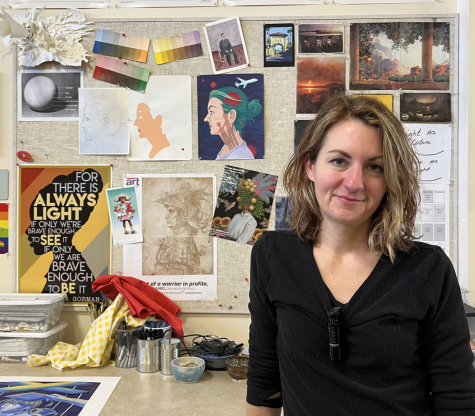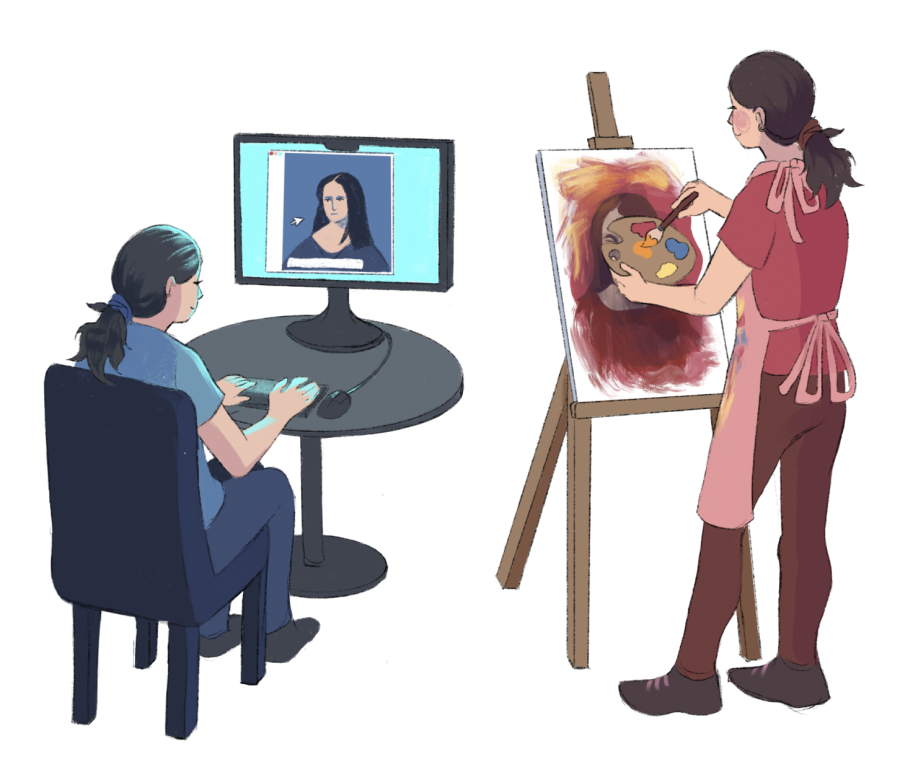Left: A student artist uses an AI to generate a simple replica of the “Mona Lisa” for a school project. Right: Another student adds some finishing touches to her hand-painted piece.
The artist’s dilemma
what AI means for the future of art
April 19, 2023
The sound of graphite against paper and the swirling of brushes in water are the only sounds in the room as students in Tracey Atkinson’s PRIME class immerse themselves in their art projects. Colorful acrylic paintings, still life studies, and portraits plastered on the walls showcase the students’ hard work.
But this same art is now easily replicated with a few clicks on your computer. As accessibility increases, AI has been used more frequently to generate art pieces.
Starting out in the late 1990s, AI was used to create computer graphics and even music and poetry, according to an article by V7 Labs, an AI annotation platform. Through online algorithms and analyzing hundreds of various pieces, people are now using artificial intelligence to generate art. Today, AI-generated art threatens to change the canvas of the art world.
Using widely accessible AI programs like Midjourney, NightCafe, and DALL-E 2, users can simply type in a few key words to produce an artwork within seconds, even replicating specific styles of professional artists. While this is a huge step forward in the advancement of technology, what it means for artists remains uncertain.
Tracey Atkinson, an art teacher at Palo Alto High School says that she, along with other art educators, are very concerned about the rise of AI-generated art. She explains that the college board just released a statement prohibiting the usage of AI art in students’ art portfolios, and she expects colleges to follow suit.
“I think the problem [with] AI is that [in] art making, you have to understand how to use the elements and principles of art and you have to understand how to make a strong composition,” Atkinson said. “And so if you press a button and somebody does that for you, you have not made a piece of art in my mind.”
Art student and senior Yuuki Matsuda said that while she is fascinated with AI generated art, she is also concerned about the effect it will have on the jobs of artists.
“I’m hoping regulations will be put towards making that [AI art] limited because I know they have that for music right now,” Matsuda said. “They’re making it just like free royalty music, so it’s not hurting anyone, technically. So I hope they do that for art. But I feel like if this keeps continuing, AI is definitely going to improve more and more to the point where it’s going to definitely start taking away some jobs. Especially since you don’t really need to pay AI that much like normal artists.”

Atkinson said that while AI platforms can be used as a tool, AI lacks the ability to make art that has meaning to it. She also said that companies should use real people to do things like advertising and marketing and not rely on AI art generating platforms to do the heavy lifting.
“I mean, doing art is creating something that people can relate to, that people feel connected to and if you know that a computer did that, is it the same?” Atkinson said. “Like if you make a piece of art about your grandmother dying and that you just put in ‘grandmother died’ and [the AI platform] makes it for you? I think companies shouldn’t just depend on it [AI generated art]. It could be a tool, perhaps, but not the answer.”
Susan La Fetra, an Art Spectrum teacher at Palo Alto High School said that AI art cannot replace art made by people because it lacks creativity. “What it means to be an artist is to be creative,” La Fetra said. “And almost by definition, AI is not creative.”
La Fetra also sees AI art generating platforms as a potential tool for artists due to its speed.
“[AI] may reduce the amount of time artists need to spend with repetitive, monotonous tasks,” La Fetra said. “And so they can spend more time on creativity.”
Art student and junior Katie Wu has a similar view and said that artists will have to adapt to AI generated art and use it as a tool. “So I think it’s not possible for artists to completely shun away AI because it can be beneficial in some ways, and definitely make the art process faster,” Wu said.
Wu said that AI still lacks the ability to do more advanced tasks, so some artists’ careers will not be impacted as of now.
“There are a lot of ideation jobs, such as visual development, or concept art, and AI can’t come up with ideas from scratch, so artists will still be needed, and also in fields like animation,” Wu said. “AI still doesn’t know how to render movement or how the intricacies of human actions work. So it’ll still take a while for AI to figure that out.”
“In the future, a lot of jobs will unfortunately be done by computers but communication I think we will always need,” Atkinson said. “And a lot of jobs in the creative industry right now are communication, and I don’t think we want to rely on computers to communicate.”

